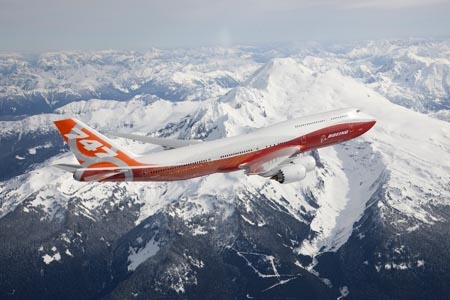New Hampshire, U.S.A. — Second generation aviation biofuels are getting ready for takeoff.When Boeing’s 747-8 freighter landed in Paris for an international air show in mid-June, it did so in style. The flight marked the first transatlantic voyage for a commercial jetliner using aviation biofuel — in this case a 15 percent blend from the camelina plant.
It wasn’t the only plane using less than traditional fuel to make a grand entrance at the show. The Honeywell-operated Gulfstream G450 became the first aircraft to fly from North America to Europe with a 50/50 blend of Honeywell Green Jet Fuel and petroleum-based jet fuel. It was also the first business jet to be powered by a biofuel.

While the high-profile landings will surely pique the interest of those new to the emerging possibilities of biofuels, the real ascent is expected to come later this year when the global standards body publishes its jet fuel specification, which could allow up to a 50 percent blend of biofuels.
After ASTM International releases its specifications, production is expected to ramp up significantly, and perhaps immediately. Boeing spokesman Terrance Scott said Monday that many airlines in the industry are working to set up agreements in preparation for the new standards.
While costs for the aviation biofuels remain higher than traditional kerosene fuel, industry experts expect prices to come down considerably with the shift from test batches to high-volume production.
Biofuels, especially second-generation methods that don’t cut into the food supply, are increasingly seen by the aviation industry as a way to offset the volatility of traditional fuel prices. The exploration in the industry has also been in response to increasing emission regulations and the potential for an aviation biofuel credit market in the European Union.
“As an industry, we have to find a way to eliminate the volatility,” said Scott. “We won’t predict when peak oil is going to happen, or whether it has already happened. But you need to get going on this.”
For it’s June 20 flight, Boeing does not need to make any changes to the airplane, its engines or operating procedures to accommodate the biofuel use. According to Honeywell, which manufactured the biofuel, no changes to airline fleets need to be made even with a 50 percent blend.
Biofuel industry
Aviation biofuels have been used in recent years in demonstration flights, both commercially and in partnership with the U.S. military.
Honeywell UOP has emerged as a leader in the production and manufacturing of aviation biofuels. Its bio jet fuel was developed under a grant from the U.S. Defense Advanced Research Projects Agency, now the U.S. Defense Logistics Agency-Energy. The process converts feedstocks like camelina — algae is among other options — into jet fuel. The company says the fuel has shown to have higher energy density in flight, which will allow aircraft to fly farther on less fuel, and that it can offer a 65 to 80 percent reduction in greenhouse gas emissions compared to petroleum-based fuels.
The biofuel for both flights was sourced from camelina grown in Montana and processed by Honeywell UOP. Plant-based biofuels like camelina provide a net reduction in carbon, meaning the CO2 it absorbs during growth is greater than what it emits when burned.
The plant was identified for its potential in aviation biofuel by Boeing and others in the Pacific Northwest as part of the Sustainable Aviation Fuels Northwest project (www.safnw.com).
In an effort to create a regional supply chain, Boeing said it is guiding assessments in Australia/New Zealand, Mexico, the United Arab Emirates and China to identify potential fuel sources that don’t compete with food or fresh water resources or contribute to deforestation.
Paris Landings
Boeing’s 747-8 took off from Washington and landed at Le Bourget Airport at about 5 p.m. local time on June 20.
The airplane was on display at the Paris Air Show June 21 and 22. It left the air show on June 22 and fly to Cargolux headquarters at Luxembourg for a two-day visit.
Honeywell’s Gulfstream departed Morristown, N.J., at 9 p.m. on June 17 and arrived in Paris about seven hours after takeoff. The jet closely followed the route taken by Charles Lindbergh’s famous first flight across the Atlantic.
Source: renewableenergyworld
 Follow
Follow